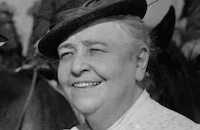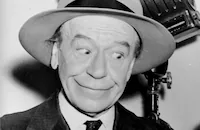Little Miss Broadway

Brief Synopsis
Cast & Crew
Irving Cummings
Shirley Temple
George Murphy
Jimmy Durante
Phyllis Brooks
Edna Mae Oliver
Film Details
Technical Specs

Synopsis
Betsy Brown bids farewell to her friends at the orphanage when she is adopted by kindly William J. "Pop" Shea. Pop and his daughter Barbara take Betsy to New York, where they run the Hotel Variety, a show business hotel full of performers who are perpetually late with their rent. Betsy thrives in the music-filled atmosphere, unlike the Variety's next-door neighbor, cranky Sarah Wendling, who is the Sheas's landlady. Tired of the noise, Sarah gives Pop five days either to pay $2,500 in back rent or move out and ignores the protests of her mousy brother, Willoughby Wendling. Pop tells the tenants they have to move, but they band together out of loyalty to Pop and pawn their belongings. Meanwhile, Betsy goes to the Wendling house to give Sarah her piggy bank as a down payment on Pop's rent. Penny is sitting on the doorstep when Roger Wendling, Sarah and Willoughby's nephew, arrives and takes her in with him. Sarah dismisses Betsy's piggy bank, as well as Roger's plea that, as a third owner in the hotel, he has some say in her plans. The disappointed pair return to the hotel, where Pop scolds Betsy, and Barbara gives Roger the cold shoulder because he is related to Sarah. Betsy and Roger then go the stuffy City Club where Willoughby and his friends practice their barbershop quartet act. After the other club members shush them, they return to the Variety, and Willoughby books the most expensive suite for a year as a rehearsal room, thereby allowing Pop to pay the rent. Later, Barbara apologizes to Roger and they being seeing each other, a development that Sarah reads about in a gossip column. Upset, Sarah rushes to the hotel and orders the young lovers to end their relationship. Sarah later sends detectives to return Betsy to the orphanage, but the girl escapes to the Wendling house with Roger, who intends to keep her there while Sarah is on vacation. A week later, Betsy is given a surprise birthday party at the Wendling house, which is interrupted by Sarah's unexpected return. Sarah's detectives take the sobbing Betsy back to the orphanage. Shortly after, Roger files suit against Sarah, trying to gain control of the hotel and his inheritance, with which he will back a show starring the hotel's residents. At the orphanage, Betsy reads about the suit, escapes and goes to the courtroom. As the main issue of the lawsuit involves the soundness of Roger's investment in the show, Judge Hart agrees to Betsy's suggestion that he view the production. The next day, Betsy, Roger and the others perform in the courtroom, and an impressed viewer offers the troupe $2,500 per week for an engagement at his International Follies. Sarah then wins everyone over when she declares that the show is worth $5,000 a week and she will not accept any less. Shortly after, Betsy requests a marriage license for her "mother and father," Barbara and Roger, who have agreed to marry.

Director
Irving Cummings
Cast

Shirley Temple

George Murphy

Jimmy Durante

Phyllis Brooks

Edna Mae Oliver

George Barbier

Edward Ellis

Jane Darwell
El Brendel

Donald Meek

Patricia Wilder

Claude Gillingwater Sr.
George Brasno

Olive Brasno
Charles Williams
Charles Coleman

Russell Hicks
Brian Sisters
Brewster Twins
Claire Dubrey
Robert Gleckler
C. Montague Shaw
Frank Dae

Eddie Collins
Syd Saylor
Jerry Colonna
Heinie Conklin
Clarence Hummel Wilson
Ben Weldon
Crew
Walter Bullock
Nick Castle
Eli Dunn
Roger Heman
David Hempstead
Bernard Herzbrun
George Leverett
Thomas Little
Arthur Miller
Hans Peters
Aaron Rosenberg
Geneva Sawyer
Louis Silvers
Harold Spina
Walter Thompson
Harry Tugend
Gwen Wakeling
Jack Yellen
Darryl F. Zanuck

Videos
Movie Clip



Film Details
Technical Specs

Articles
Little Miss Broadway
Originally titled Little Lady of Broadway, the film was directed by Irving Cummings with the screenplay by Harry Tugend and lyricist-turned-screenwriter Jack Yellen (who wrote the lyrics for classics like Happy Days are Here Again and Ain't She Sweet?), although studio chief and executive producer Darryl F. Zanuck is said to have personally rewritten the final draft of the script. Little Miss Broadway was shot on the 20th Century-Fox lot between February 7th and late March 1938.
George Murphy, who would later become a California state senator, began his career as a song and dance man. He was not satisfied with the choreography of the film's closing number, We Should Be Together and asked Fox management to have it restaged. According to those on the set, while Temple's mother (who was always present during filming) was not happy about it, Shirley herself was all for the idea, and after the number was filmed Murphy and Temple repeated the routine just for fun. Murphy's involvement in this film would later benefit him in a way he could not have predicted in 1938. While running for senator, Murphy would later say, "Those old pictures showing me dancing with Shirley Temple that keep turning up on the late night TV movies are getting me votes." Another musical number, which took place during the courtroom scene, featured Temple with Jimmy Durante. While the studio released publicity shots from this number, it was cut out from the final film.
According to a website devoted to the Brian Sisters, the sisters were missing their youngest member, Gwen, who was not only the same age as Temple, but prettier and a better singer, causing Temple's mother to think Gwen would show up her daughter. Gwen was cut from the film, which angered her sisters Betty and Doris, but they agreed to appear when Gwen was paid her salary, anyway. They were also not happy with having to change their style in order to sing with Temple. According to Doris Brian, "Betty and I had to sing with Shirley. She was a good actress and a great little dancer, but not much of a singer. At the recording session, Betty and I were singing as we usually did, but Shirley could not blend with us. The musical director cautioned us to '...sing it the way Shirley does'."
The critics were mixed when Little Miss Broadway was released in July 1938. Frank S. Nugent of The New York Times felt that Temple's films had devolved into "poses." "Pose No. 1 has her singing a song of optimism to the other little girls, including the Brian sisters, at the home. Attitude No. 2 has her round little chin quivering as she says good-bye to all her tiny playmates. [...] In No. 3 she is making friends with Jimmy Durante, the midgets, the mind-reading act and the ventriloquist of the theatrical hotel. Plate 4 involves the mean old lady next door who owns the hotel and Slide No. 5 deals with the old lady's nice young nephew, George Murphy, and Pop Shea's pretty daughter, Phyllis Brooks." Despite its plot growing old and Temple growing older, Little Miss Broadway turned out to be the eighth biggest box-office draw of 1938.
By Lorraine LoBianco
SOURCES:
Bakish, David Jimmy Durante: His Show Business Career, with an Annotated Filmography and Discography
http://www.bidnessetc.com/business/shirley-temple-the-little-girl-that-saved-20-th-century-fox/
http://www.brian-sisters.org/LittleMissBroadway.shtml
The Internet Movie Database
Nancy, Peter John Garfield - Unabridged Guide
Nugent, Frank "The Screen; Shirley Temple Forces a Dimple in Her New Picture 'Little Miss Broadway' at the Roxy" The New York Times 23 July 38
Ross, Stephen J. Hollywood Left and Right: How Movie Stars Shaped American Politics
http://www.tcm.com/tcmdb/title/81551/Little-Miss-Broadway/full-synopsis.html

Little Miss Broadway
Quotes
Trivia
Notes
A 17 January 1938 Hollywood Reporter news item refers to this film as Little Lady of Broadway. A pre-release Motion Picture Herald article credits Jimmy Durante with additional music and lyrics. A Twentieth Century-Fox publicity release lists Patricia Randolph in the cast, but her participation is not confirmed by contemporary reviews. Little Miss Broadway is not related to a 1947 Columbia film of the same name, directed by Arthur Dreifuss and starring Jean Porter. Jule Styne, in his autobiography, states that he was Shirley Temple's vocal coach for this film. Modern sources assert that executive producer Darryl F. Zanuck wrote most of the final screenplay for this film, and note that Eleanor Roosevelt visited Shirley Temple on the set during filming.














